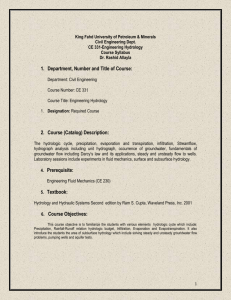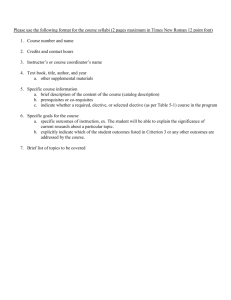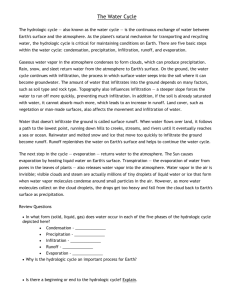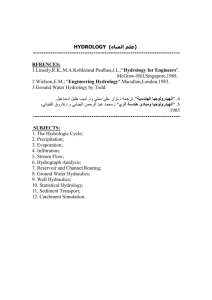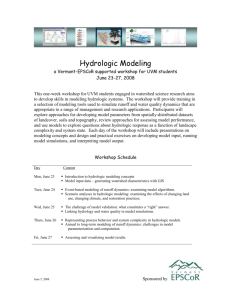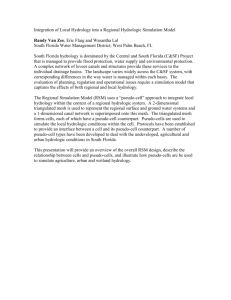Course description of Hydrology
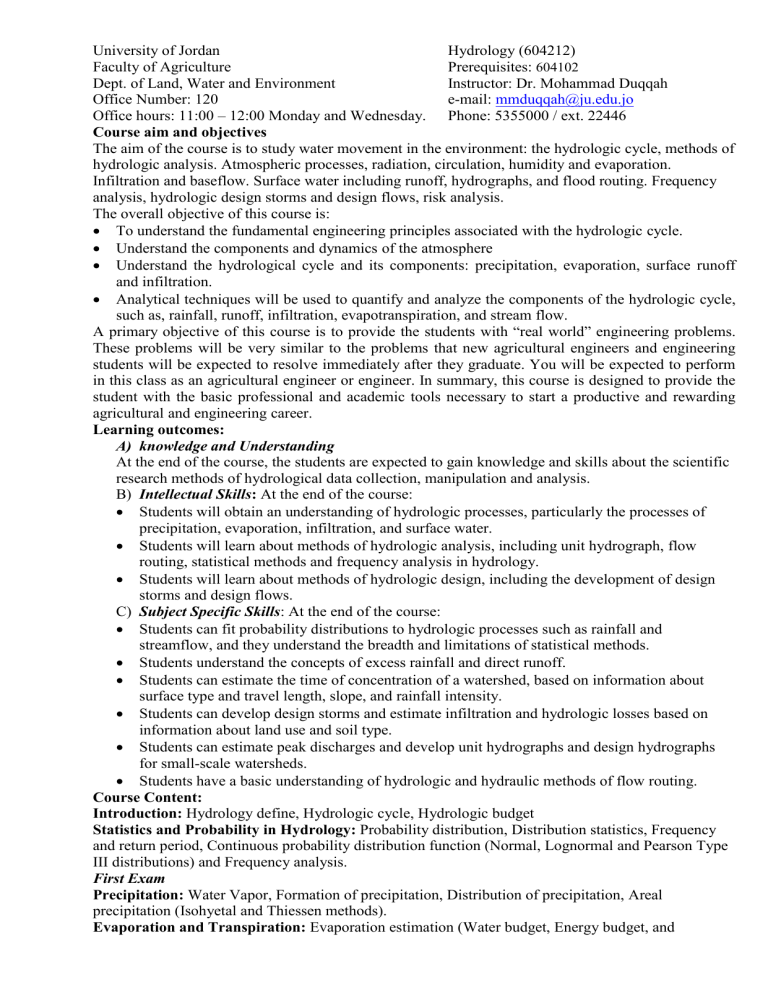
University of Jordan
Faculty of Agriculture
Dept. of Land, Water and Environment
Office Number: 120
Office hours: 11:00 – 12:00 Monday and Wednesday.
Hydrology (604212)
Prerequisites: 604102
Instructor: Dr. Mohammad Duqqah e-mail: mmduqqah@ju.edu.jo
Phone: 5355000 / ext. 22446
Course aim and objectives
The aim of the course is to study water movement in the environment: the hydrologic cycle, methods of hydrologic analysis. Atmospheric processes, radiation, circulation, humidity and evaporation.
Infiltration and baseflow. Surface water including runoff, hydrographs, and flood routing. Frequency analysis, hydrologic design storms and design flows, risk analysis.
The overall objective of this course is:
To understand the fundamental engineering principles associated with the hydrologic cycle.
Understand the components and dynamics of the atmosphere
Understand the hydrological cycle and its components: precipitation, evaporation, surface runoff and infiltration.
Analytical techniques will be used to quantify and analyze the components of the hydrologic cycle, such as, rainfall, runoff, infiltration, evapotranspiration, and stream flow.
A primary objective of this course is to provide the students with “real world” engineering problems.
These problems will be very similar to the problems that new agricultural engineers and engineering students will be expected to resolve immediately after they graduate. You will be expected to perform in this class as an agricultural engineer or engineer. In summary, this course is designed to provide the student with the basic professional and academic tools necessary to start a productive and rewarding agricultural and engineering career.
Learning outcomes:
A) knowledge and Understanding
At the end of the course, the students are expected to gain knowledge and skills about the scientific research methods of hydrological data collection, manipulation and analysis.
B) Intellectual Skills: At the end of the course:
Students will obtain an understanding of hydrologic processes, particularly the processes of precipitation, evaporation, infiltration, and surface water.
Students will learn about methods of hydrologic analysis, including unit hydrograph, flow routing, statistical methods and frequency analysis in hydrology.
Students will learn about methods of hydrologic design, including the development of design storms and design flows.
C) Subject Specific Skills : At the end of the course:
Students can fit probability distributions to hydrologic processes such as rainfall and streamflow, and they understand the breadth and limitations of statistical methods.
Students understand the concepts of excess rainfall and direct runoff.
Students can estimate the time of concentration of a watershed, based on information about surface type and travel length, slope, and rainfall intensity.
Students can develop design storms and estimate infiltration and hydrologic losses based on information about land use and soil type.
Students can estimate peak discharges and develop unit hydrographs and design hydrographs for small-scale watersheds.
Students have a basic understanding of hydrologic and hydraulic methods of flow routing.
Course Content:
Introduction: Hydrology define, Hydrologic cycle, Hydrologic budget
Statistics and Probability in Hydrology: Probability distribution, Distribution statistics, Frequency and return period, Continuous probability distribution function (Normal, Lognormal and Pearson Type
III distributions) and Frequency analysis.
First Exam
Precipitation: Water Vapor, Formation of precipitation, Distribution of precipitation, Areal precipitation (Isohyetal and Thiessen methods).
Evaporation and Transpiration: Evaporation estimation (Water budget, Energy budget, and
Evaporation Pan), Evapotranspiration estimation (Penman method).
Infiltration: Measuring infiltration, Green-Ampt Model, SCS Runoff Curve Number procedure.
Second Exam
Surface Water Hydrology: Streamflow ( Streamflow measurements by Direct method and Slope-Area method), Runoff (Catchments, Rainfall-Runoff Process)
Hydrographs: Hydrograph components, Hydrograph Time relationship, Unit Hydrograph (Definition, derivation of Unit Hydrographs from Streamflow, Unit Hydrograph application by Lagging and S-
Hydrograph method), and Hydrograph Routing.
Final Exam, comprehensive
Tests and Evaluation:
Midterm Exam
Quizzes
Final hour exam
Teaching Methods:
30%
20%
50%
1) Duration: 16 weeks including exams.
2) Lectures: 32 lectures each one and half hour including tests and final exam.
3) In-class Quizzes: There will be announced in-class quizzes throughout the semester every
Monday. These quizzes will generally be closed-book and will cover the most recently completed subjects or homework assignments.
Textbook:
Introduction to Hydrology . 2003. Warren Viessman, Jr and Gary L. Lewis. Addison-Wesley
Educational Publishers, Inc. Fifth edition.
References:
Hydrology and Water Quantity Control . 1990. Martin P. Wanielista... John Wiley and Sons
Handbook of Applied Hydrology . 1964. Ven Te Chow (ed.)... McGraw-Hill


